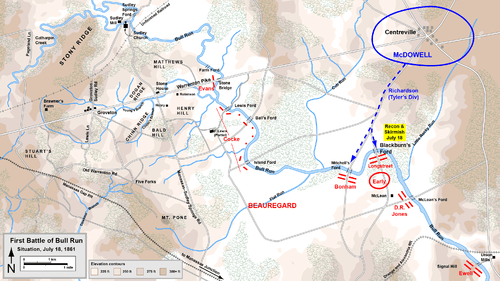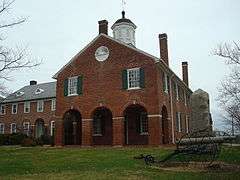Battle of Blackburn's Ford
| Battle of Blackburn's Ford | |||||||
|---|---|---|---|---|---|---|---|
| Part of the American Civil War | |||||||
 Blackburn's Ford | |||||||
| |||||||
| Belligerents | |||||||
|
|
| ||||||
| Commanders and leaders | |||||||
|
Irvin McDowell Daniel Tyler[1] |
P.G.T. Beauregard James Longstreet[2] | ||||||
| Strength | |||||||
| 3,000[3] | 5,100[3] | ||||||
| Casualties and losses | |||||||
| 83[4] | 68[4] | ||||||
The Battle of Blackburn's Ford took place on July 18, 1861, in Prince William County and Fairfax County, Virginia, as part of the First Manassas Campaign of the American Civil War. A Union brigade was ordered to probe the Confederate defenses along Bull Run to locate the Confederate left. At Blackburn's Ford, the brigade attempted to cross but Confederate fire broke up the attack and Union commanders decided to cross the creek farther upstream.
Background
On July 16, 1861, the untried Union Army of Northeastern Virginia under Brig. Gen. Irvin McDowell, 35,000 strong, marched out of the Washington, D.C., defenses to give battle to the Confederate Army of the Potomac, which was concentrated around the vital railroad junction at Manassas. Moving slowly, the army reached Fairfax Court House on July 17; the next day, McDowell ordered division commander Brig. Gen. Daniel Tyler to look for a fording point across Bull Run Creek and to "keep up the impression that we are moving on Manassas".[5]
The Confederates, about 22,000 men under the command of Brig. Gen. P.G.T. Beauregard, were concentrated near Bull Run, with detachments spread north of the creek to observe the Federals. When McDowell started his advance from Washington, the Confederate detachments slowly retreated and rejoined the main body. Beauregard expected to be attacked either on the 18th or the 19th near Mitchell's Ford; meanwhile, he continued to ask for reinforcements, especially from Joseph E. Johnston's army in the Shenandoah Valley.[6]

Battle

On July 18, Tyler advanced to Centreville and found that Centreville was unoccupied by Confederate troops. He then marched southeast to Mitchell's Ford and Blackburn's Ford, arriving at the latter about 11 a.m. Looking south across the stream, Tyler believed that the road to Manassas Junction was clear, but he failed to see the Confederate brigade of Brig. Gen. James Longstreet concealed in the woods behind the ford. He ordered two howitzers under Capt. Romeyn B. Ayres to bombard the Confederates he could see, guns of the Alexandria Artillery and the Washington Artillery, but the fire had no visible effect. He ordered Col. Israel B. Richardson and part of his brigade forward.[7]
Richardson's advance met initial resistance from the 1st, 11th, and 17th Virginia Infantry regiments of Longstreet's brigade. Tyler ordered Ayres to move his guns closer to the action, accompanied by cavalry, and he sent the rest of Richardson's brigade toward the ford. Richardson's assault fell apart as the 12th New York Infantry began to retreat under heavy fire, causing a wave of panic to spread through the Union line.[8]
Col. Jubal A. Early arrived with his Confederate brigade after marching 2 miles north from Beauregard's headquarters at Wilmer McLean's house. The availability of this additional firepower completed the Confederate victory, and a reinforced Washington Artillery kept the Union troops under fire as they retreated. Colonel Patrick T. Moore of the 1st Virginia Infantry, later a Confederate brigadier general, received a severe head wound in the skirmish and was incapacitated for further field service.[9]
Aftermath
The failed reconnaissance-in-force at Blackburn's Ford led McDowell to decide against a frontal assault along Bull Run. He decided to attempt to cross the stream beyond the Confederate left flank, the maneuver he employed at the First Battle of Bull Run on July 21.[10]
Both Longstreet and Early claimed later that the battle "went a long way towards winning the victory of the 21st, for it gave our troops confidence in themselves".[11]
Notes
External links
References
- Davis, William C. Battle at Bull Run: A History of the First Major Campaign of the Civil War. Baton Rouge: Louisiana State University Press, 1977. ISBN 0-8071-0867-7.
- Detzer, David. Donnybrook: The Battle of Bull Run, 1861. New York: Harcourt, Inc., 2004. ISBN 0-15-100889-2.
- Kennedy, Frances H., ed. The Civil War Battlefield Guide, 2nd ed. Boston: Houghton Mifflin Co., 1998. ISBN 0-395-74012-6.
- Salmon, John S. The Official Virginia Civil War Battlefield Guide. Mechanicsburg, PA: Stackpole Books, 2001. ISBN 0-8117-2868-4.
- Warner, Ezra J. Generals in Gray: Lives of the Confederate Commanders. Baton Rouge: Louisiana State University Press, 1959. ISBN 0-8071-0823-5.
- Wert, Jeffry D. "Moore, Patrick Theodore" in Historical Times Illustrated History of the Civil War, edited by Patricia L. Faust. New York: Harper & Row, 1986. ISBN 978-0-06-273116-6.
Coordinates: 38°48′15″N 77°26′57″W / 38.80417°N 77.44917°W
